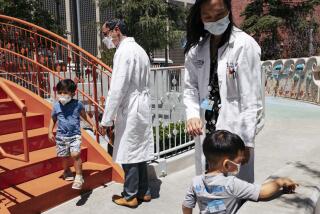Working Mom’s Kids Are Healthy, Says New Study
- Share via
WASHINGTON — Children with working mothers are no more likely to get sick and stay home from school than children whose mothers do not work, according to data collected by the National Center for Health Services Research.
More women with small children are working than ever before in the nation’s history, but fears that the children of working mothers would be neglected are challenged by the study, which shows that children with or without working mothers appear to have about the same number of sick days at home, or more seriously, sick days confined to bed.
The study is based on a survey of households with 5,538 children between 1 and 11.
The authors are Gail Lee Cafferata of the Center and Judith Kasper of the Health Care Financing Administration, both units of the Department of Health and Human Services.
They said the findings demonstrate that “employment of women has not affected the way in which they seek care for ill children,” nor undermined the mother’s primary role as “a gatekeeper to the health care system” for her children.
In the past quarter-century there has been a tremendous surge of women working outside the home. Between 1960 and 1984, the proportion of married women who were in the labor force and had children under 6 rose from 18.6% to 51.8%, with even higher percentages for those with older children and for divorced and separated women.
Data Collected
Data for the new study was collected from the 1977 National Medical Care Expenditures Survey, and the authors said it showed that:
--Among children aged 1 to 11, 72.6% had at least one day of illness per year. The figure was pretty much the same whether the mother worked or not. If mothers worked full time, 71.4% of the children were sick at least one day; if mothers worked part time, 74.5%, and if mothers did not work outside the home, 71.9%.
--Among all children sick enough not only to be counted as ill, but also to have to stay in bed for at least one day, again there were only tiny differences between families with mothers working or not working. If mothers worked full time, the proportion was 58.4% of children who spent at least one day sick in bed. If mothers worked part time, the figure was 62.7%, and if mothers did not work outside the home, it was 59.4%. The proportion taking the child to the doctor at least once was virtually the same for all three groups--74.7% if the mother worked full time, 78.1% if she worked part time and 78% if she did no outside work. The study also found that the percentage making phone calls to the doctor was virtually the same whether the mother worked or not.
One Variation
The study did find one variation in a small subgroup of all the children. Looking at the few children who suffered no days of illness during the year, it found that mothers who stayed at home took the children to the doctor about 10% more often than mothers who worked full time. The full-time mothers also called the doctor more often. The authors said this suggests that they are giving more attention to preventive medicine.
The authors found that factors other than employment of the mother affect the number of visits to the doctor. “Low-income children and those without insurance or without a usual source of care are all less likely to see a physician, as expected,” they said, and the children of mothers who go to the doctor frequently themselves are more likely to go to the doctor.






